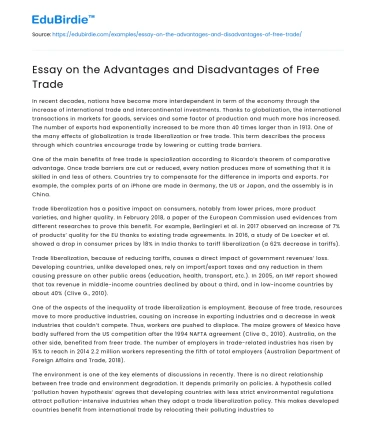In recent decades, nations have become more interdependent in term of the economy through the increase of international trade and intercontinental investments. Thanks to globalization, the international transactions in markets for goods, services and some factor of production and much more has increased. The number of exports had exponentially increased to be more than 40 times larger than in 1913. One of the many effects of globalization is trade liberalization or free trade. This term describes the process through which countries encourage trade by lowering or cutting trade barriers.
One of the main benefits of free trade is specialization according to Ricardo’s theorem of comparative advantage. Once trade barriers are cut or reduced, every nation produces more of something that it is skilled in and less of others. Countries try to compensate for the difference in imports and exports. For example, the complex parts of an iPhone are made in Germany, the US or Japan, and the assembly is in China.
Save your time!
We can take care of your essay
- Proper editing and formatting
- Free revision, title page, and bibliography
- Flexible prices and money-back guarantee
Trade liberalization has a positive impact on consumers, notably from lower prices, more product varieties, and higher quality. In February 2018, a paper of the European Commission used evidences from different researches to prove this benefit. For example, Berlingieri et al. in 2017 observed an increase of 7% of products’ quality for the EU thanks to existing trade agreements. In 2016, a study of De Loecker et al. showed a drop in consumer prices by 18% in India thanks to tariff liberalization (a 62% decrease in tariffs).
Trade liberalization, because of reducing tariffs, causes a direct impact of government revenues’ loss. Developing countries, unlike developed ones, rely on import/export taxes and any reduction in them causing pressure on other public areas (education, health, transport, etc.). In 2005, an IMF report showed that tax revenue in middle-income countries declined by about a third, and in low-income countries by about 40% (Clive G., 2010).
One of the aspects of the inequality of trade liberalization is employment. Because of free trade, resources move to more productive industries, causing an increase in exporting industries and a decrease in weak industries that couldn’t compete. Thus, workers are pushed to displace. The maize growers of Mexico have badly suffered from the US competition after the 1994 NAFTA agreement (Clive G., 2010). Australia, on the other side, benefited from freer trade. The number of employers in trade-related industries has risen by 15% to reach in 2014 2.2 million workers representing the fifth of total employers (Australian Department of Foreign Affairs and Trade, 2018).
The environment is one of the key elements of discussions in recently. There is no direct relationship between free trade and environment degradation. It depends primarily on policies. A hypothesis called ‘pollution haven hypothesis’ agrees that developing countries with less strict environmental regulations attract pollution-intensive industries when they adopt a trade liberalization policy. This makes developed countries benefit from international trade by relocating their polluting industries to other developing countries, resulting in a 43% increase in CO2 emissions abroad (Harvard Business Review, 2019). A good illustration of this hypothesis is the spent batteries Americans send for recycling to Mexico by using some crude methods exposing locals to dangerous levels of toxic metal (The New York Times, 2011).
Free trade is indeed concerned as an economic booster, but the advantages are not guaranteed for everyone. It is a double-edged sword.






 Stuck on your essay?
Stuck on your essay?

